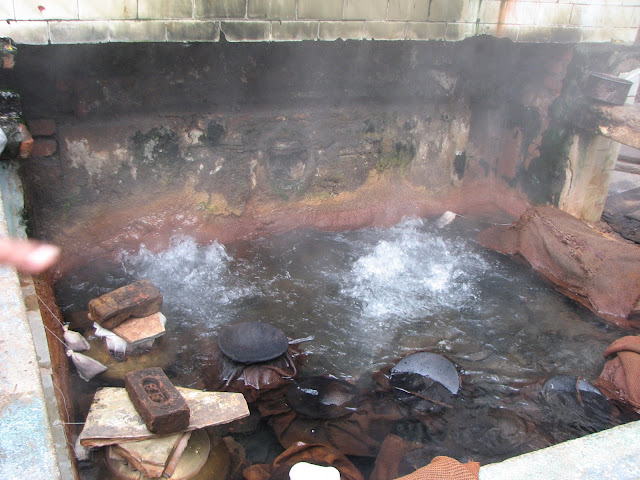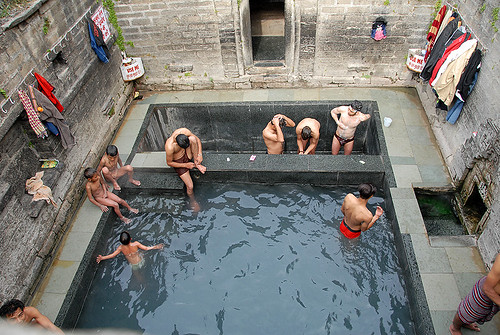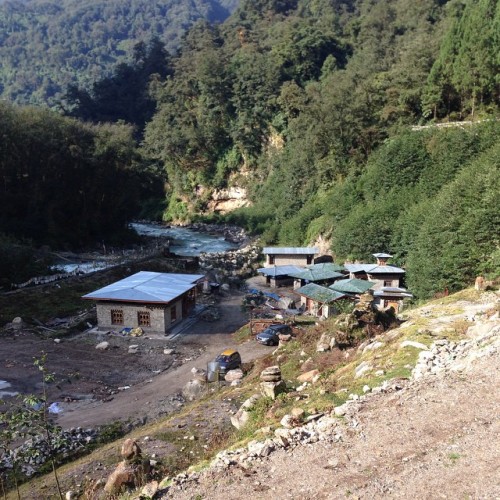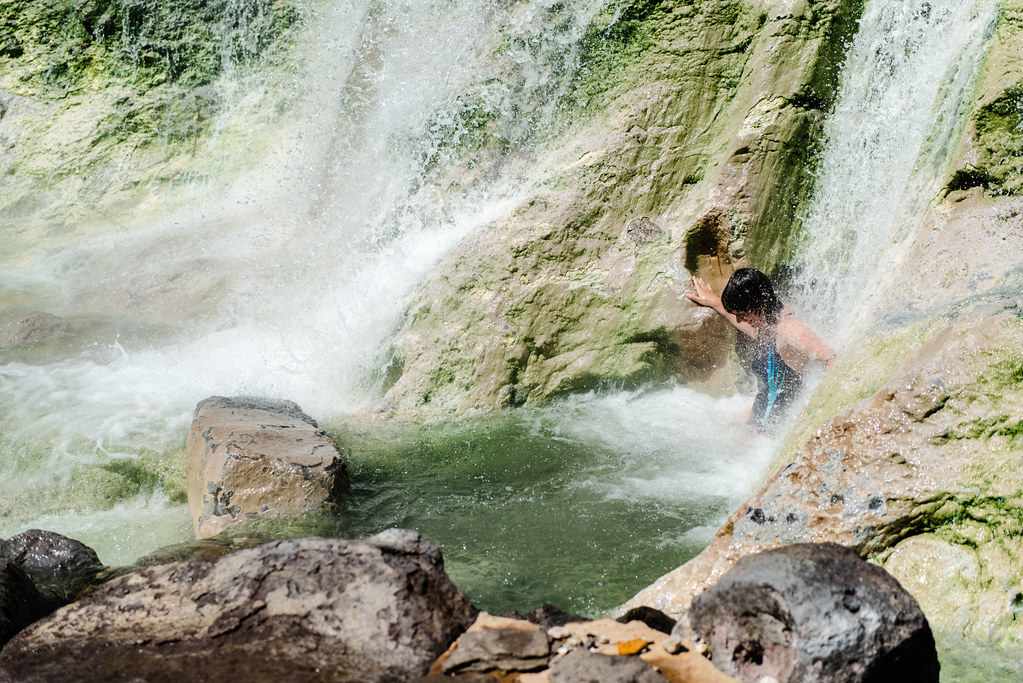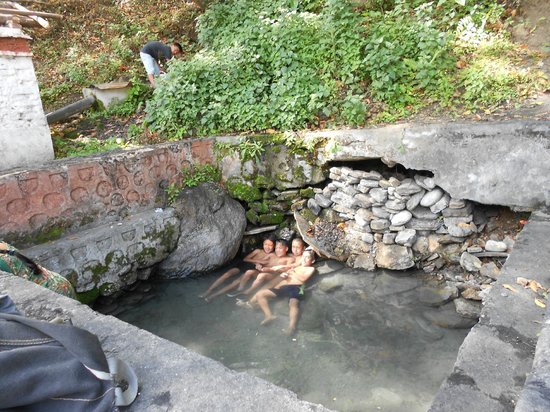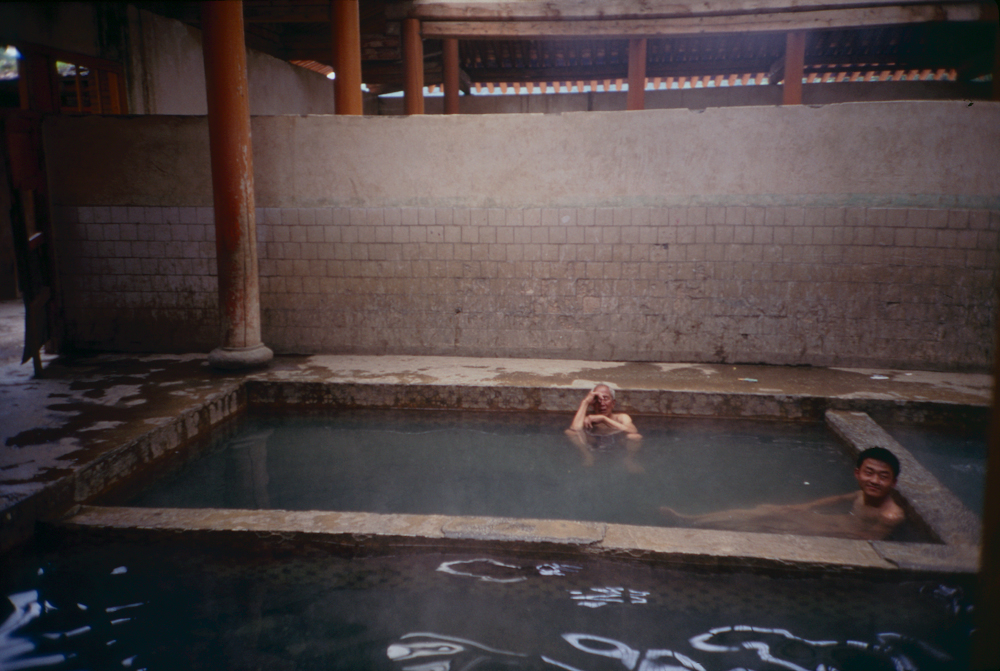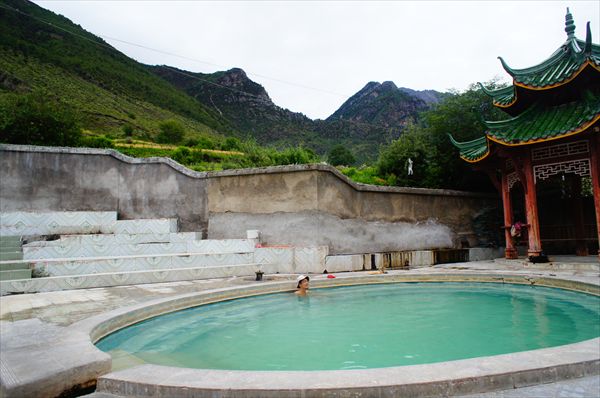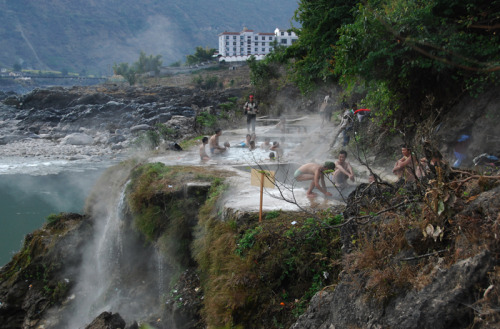A heavily updated entry of the hot soaks of Himachal Pradesh:
Following on the trail of the Indian sub-continent side of the Himalaya we have already featured Arunchal Pradesh state, Bhutan, Sikkim state, Nepal and Kashmir.
South of Kashmir, but north of the Ganges plain lies Himachal Pradesh. Extremely convenient is the existence of a web site featuring Himachal Pradesh's hot springs, which mentions that the hot springs are popular. Most are located in Kullu district.
Following on the trail of the Indian sub-continent side of the Himalaya we have already featured Arunchal Pradesh state, Bhutan, Sikkim state, Nepal and Kashmir.
South of Kashmir, but north of the Ganges plain lies Himachal Pradesh. Extremely convenient is the existence of a web site featuring Himachal Pradesh's hot springs, which mentions that the hot springs are popular. Most are located in Kullu district.
Out of Kullu
In Himachal Pradesh (or let's use HP) there are only two hot springs outside of Kullu that I could find; at least on the web. One is that of Tattapani. Located in Mandi district, this hot spring is just beyond 50 km to the northwest of the state capital of Shimla.
From the hotel website:
There must be natural public springs as well. Go2india.in:
In Himachal Pradesh (or let's use HP) there are only two hot springs outside of Kullu that I could find; at least on the web. One is that of Tattapani. Located in Mandi district, this hot spring is just beyond 50 km to the northwest of the state capital of Shimla.
'It is located on the right bank of river Satluj at an altitude of 656 meters. This natural sulphur spring is pure and has curative power for various kings of bodily ailments'.There's a recently constructed place called Hotel Hot Spring Therme and Spa which seems to be the host of the hot spring. Tripadvisor notes that it has four and a half stars. It has a larger, more public pool and two smaller private pools.
From the hotel website:
'Tattapani is famous for its natural hot sulphur spring gushing out at the temperature of 65 degree Celsius near the the river. From the ancient time the local population well known the miraculous property of this water and come from all over the state to take a dip into the sulphur spring: this provides relief to the people suffering from joint pains, fatigue and stress or any type of skin disease and hence has got a great medicinal quality'.
There must be natural public springs as well. Go2india.in:
'Tattapani is famous for hot spring water coming out by the side of Sutlej River. These hot waters came out from different places on the river bed at Tattapani'.The hot springs are highly frequented on the festival of Makar Sakranti which heralds the suns movement into the northern hemisphere and is considered an auspicious occasion to take a soak. Some recent dips have seen crowds upwards of 25,000 (source)!
'These hot water springs are situated on the bank of Sutlej river. The river is at 4-5 deg. celsius while the springs are at 60-70 deg. celsius. So you have to mix both waters to enjoy the bath'.
View of Hot water springs-
There is though some doubts as toward the future of Tattapani. The Tribune (Jan. 16, 2013):
'Local hoteliers, pilgrims and residents demand the immediate revival of the legendary hot sulphur springs at a higher side of the 800-MW Kol Dam project to save this tiny hot spring healing baths destination from “imminent manmade disaster”.Since this info, the hydro project has been stalled due to technical problems (source), but submersion is the most likely outcome in the near future. The Times of India (Jan. 15, 2014):
The National Thermal Power Corporation (NTPC) has asked the local administration to vacate the bathing sites by February 22 to make way for the filling of the dam for the project. This notification has spelt doom for local small-time vendors and pandas, who make a living from managing the bathing ghats for pilgrims performing rituals of “tula daan” and bathing along the bank of the Sutlej round the year'.
'The devotees on Tuesday took ‘last dip’ in the holy waters and hot springs of Tatapani situated on the right bank of Satluj River to mark Makar Sankranti, considered a holy day.Progress? What if they had tried to develop the geothermal potential?
Sources said that unusual rush of pilgrims was seen here on Makar Sankranti probably due to the fear of submergence of this site in dam waters. Around one lakh [100,000] pilgrims took holy dip at natural hot water springs at Tattapani.
...
Both the hot springs bath sites will be submerged in the reservoir of 800-MW Kol dam by the end of this year as the National Thermal Power Corporation (NTPC) authority has started filling up the dam.
“We have started the process to fill the dam reservoir from third week of December last year and it will be filled within 300 days. The water will be stored up to the elevation of 642 meters which will submerge the many areas including the hot springs of Tattapani,” Praveen Bharti, spokesman NTPC project at Kol Dam site said. He claimed that the NTPC authority has relocated the hot water springs at a higher location.
Sources said that NTPC authority has already paid the compensation to the local people here for the land which will be submerged in the reservoir water. Kol dam, the flagship hydro-power project of the NTPC shall be ready to generate power by 2014-15'.
Anyway, the other hot spring in Mandi district is Jeori, located in Kinnaur district (source).
Jeori, source
A soak to worship
A number of hot springs are located not far from each other in Kullu district, near the town of Manali.
On the bank of the Parvati river, are the hot springs known as Manikaran which appear along a 1 km long built-up strip. The waters are very hot and besides being used for soaking purposes, they are used to boil meals; a Sikh temple here specializes in producing such meals. The religious significance for the Sikhs and the Manikaran hot springs finds it's origins in that the thermal springs were visited by a Sikh Guru Nanak Dev. This had lead to there being a number of hot pools specifically for Sikh.
On the bank of the Parvati river, are the hot springs known as Manikaran which appear along a 1 km long built-up strip. The waters are very hot and besides being used for soaking purposes, they are used to boil meals; a Sikh temple here specializes in producing such meals. The religious significance for the Sikhs and the Manikaran hot springs finds it's origins in that the thermal springs were visited by a Sikh Guru Nanak Dev. This had lead to there being a number of hot pools specifically for Sikh.
Besides religious significance for the Sikh, Hindu's also see religious significance in the hot springs, according to this legend:
'According to a legend, Manikaran is associated with Lord Shiva and his consort Parvati. Mani Karan means Ear Rings - it is said that once, while taking bath here, Maa Parvati lost her ear rings in the Kund (pond). When she told it to Lord Shiva, he became furious and looked at the water of the kund with great anger and then thousands of ear rings flowed out from the boiling water and since then the water of the spring is boiling'.
There are many video's of Manikaran, follow the link to just a few on You Tube.
But besides cooking and religion, there are also soaking sites. A recent (July, 2014) experience:
But besides cooking and religion, there are also soaking sites. A recent (July, 2014) experience:
'When we got to the hot springs, I asked if I could dip my foot into the water. He sent us upstairs to house of worship. On the second try, he pointed out the men’s and woman’s bathing sites. The men’s site was out in the open and anyone walking by could look in. I got into the hot spring water and posed for some pictures. When I got out, I asked Kim how her experience was. She told me that she left the women’s area. After getting past the door, all of the women were bathing in the nude. She got out of there without dipping even a toe in the water! I told her I would have traded places with her!!
'Pilgrims bathe in the hot springs of Manikaran next to the roaring Parvati River'.
Further Upstream
Besides being a haven for Israeli tourists (source), Kasol (which is 1 km further upstream from Manikaran) also has a hot spring. Or hot springs. The temperature is said to be lower than that of Manikaran, affording visitors with a real possibility to soak and not scald.
It's quite difficult to pinpoint the hot spring exactly. Following are 3 links to photo's of hot springs in or near Kasol, but all looking differently. FractalEnlightenment.com, Shailpanoramio and Yossi. The former though is a private hot spring attached to the Taji guesthouse, more out of town. Apparently there is more than 1 site; there's even a reference mentioning springs on both sides of the river. Though another states:
'Hot water emerges only at one location at Kasol'.
Taking a bath in one of the hotsprings in Kasol #kasauli #hotspring #himachal #pradesh #india
'Kasol is a backpacker’s paradise. This tiny village is inhabited mostly by tourists from Israel which is why most of the hoardings are in Hebrew and even in restaurants, one would find Israeli menus mostly. Kasol is ideal for a vacation if you want to chill in the lap of nature'.From this photo I deduce that there also hot tub huts for rent:
My divine treat, a deluxe hot bath.
Naturally
While researching hot soaks in the Indian administered parts of the Himalaya, one of the only hot springs still remaining in it's true natural surroundings is the hot spring of Khirganga (Kheer Ganga / Kheerganga). Khirganga is located another 12 km upstream of Kasol and can only be reached on foot.
From Wikipedia:
'... the trail ascends further through thick pine forests to the spiritual site of Khirganga (Kheerganga), a meadow at 2960m where Shiva is said to have meditated for 3000 years. The hot springs at Khirganga are extremely important for Hindu and Sikh pilgrims as well as many others who believe the waters have sacred healing properties'.The end of the journey means a chance to soak in near natural surroundings with views of majestic Himals.
But only for men. In India, women can't been seen in whatever state of undress in combibnation with water (unless of course it's a Bollywood blockbuster) so they have to be content with the view of 4 walls. Which is a pity if you see the magnificent surroundings.
The name Khirganga refers to white milk, the substance these waters near in colour, probably due to the sulphur content.

'KhirGanga hot springs'by ohad_katzin. In front the pool for men,
behind the shed for women (with improvised skylight); out of soaking site the incredulous view. Since though, the roof has fallen into disrepair ...
Experiencing the women's soak ...
Closer to Mainali is the village of Vashisht which (like Manikaran above) has many springs covering a wider area. With access to Mainali guaranteed, Vashisht (or Vashist) has become famous for it's hot springs; it's reputed that daily nearly 3,000 visitors come for a soak, though this description mentions it to be a small peaceful village .....
As with Manikaran, this Vashisht hot springs have been listed in India's top ten of hot springs.
As with Manikaran, this Vashisht hot springs have been listed in India's top ten of hot springs.
In common with nearly everywhere in India, the appearance of hot water springs has lead to the establishment of temples, here named after the spiritual master of Rama, Vashishta.
'Inside the grounds of the Vasistha Temple there are two hot spring pools that are free. They can get a bit dirty'.A real experience:
'... the hot water springs that flow into an area in the village, from the mountains, boiling water, and the smell of sulphur, where they all do not only their washing of clothes but soap themselves all over the men and boys in their underpants, and wash/bathe... then of course the Public bathing areas of which there are three, like open air mini swimming pools, fed by the hot spring water where every Tom dick and Harry lounge and bathe, right by the old Vashisht Temple of which there are a few here,(temples) there are the free common public baths, which look utterly disgusting and unhygienic, then regular baths and the deluxe baths, looking at them I don't think I personally would want to step foot in any!! Particularly as you can be seen from the cafes and guest houses above getting changed...well maybe not in the private deluxe ones but no thanks all the same!!! The Indian pilgrims come to ceremoniously bathe in the hot spring waters and visit the temples here..... '
Obviously this was blogged by a man.
'I went into the bath yesterday. There were a couple of Indian women and several little girls. The water was really hot. I have a little thermometer attached to my bag and I took it in the water with me the first time, 112 degrees. I got in and out, my feet feeling more and more cooked each time and playing with the little girls. Indian tourists from other parts of the country came and went, just dipping their feet into the water for blessing. Public places in India are usually filled with men so it was really refreshing to be around all women. I will be headed back there in the evening when the weather cools off a little bit'.
'Hot springs! Vashisht is blessed with an unlimited supply of scalding hot water, and the townsfolk are appropriately grateful. The source of the springs has a temple built around it where locals come daily to wash and pray. Foreigners are also welcomed into the temple's relaxing sulfuric pools. Inside the temple there are two pools for men and women separated by an ancient stone wall. Kara was pleasantly surprised to see that the strict taboo against nudity dissolved into the steam of the women's bathing area. It was the first time Kara ever saw an Indian woman showing her full skin in the 11 months she has spent in India. Go women of Vashisht! she says. Max was disappointed that the men's pool was in full view of the street above, and so he could not enjoy full relaxation in his birthday suit. Both pools are piping hot and it is a test of endurance to submerge one's full body in the holy water. We always left the hot springs completely rejuvenated and calm. Unfortunately photos are prohibited in the temple...'.
Unfortunately this, however it's not the only such amazing experience.
Ashley in a blog adds to what I believe is also a hot spring visit to Vashisht:
Ashley in a blog adds to what I believe is also a hot spring visit to Vashisht:
'The female body is sacred in India. They do everything they can to cover their bodies and sometimes will be married for years before even their husbands see them nude. ... As I entered the hot spring I couldn't believe my eyes. There were about a dozen nude women, all shapes, sizes and ages, laughing and slashing about, scrubbing each others backs and just having a grand old time'.
'Bathing with those women in the hot springs day after day I felt my attitude and self image shifting. Being a young woman growing up in American culture you have societal pressures placed on your body image. I never thought of myself as being insecure about my image but I found myself subconsciously judging others. Not on purpose, but just as a result of our societies labels on beauty. I always wanted children, a lot of them, but I did worry about the toll child baring would take on my body. What I saw in those hot springs was pure, natural, unmanipulated beauty. Everyone of them was perfect and there was not even a glimpse of judgment or shame. It was so inspiring and erased and fear of aging I may have had. Their confidence was beautiful, their smiles were beautiful, the love in their eyes was beautiful, and every curve on their body was absolutely beautiful!'
As is the description.
Besides the public pools, HP Tourism Development Corp. is said to be running
Besides the public pools, HP Tourism Development Corp. is said to be running
'turkish style baths'
with more private facilities. Their own web site fails to mention this .... This site mentions that it is due to a dispute between
'... the villagers and the Himachal government regarding payments and the water supply that the villagers believe to be theirs by right. In the meantime, the only place for a hot soak is in the bathing pools of Vashisht’s ancient temple (free) which is far more atmospheric anyway'.
Such is the fame of Vashist, that the Tribune (7 Dec. 2008) even mentions it's a significant place for local Gods and Goddesses:
'Vashisht village is not only known for its hot water springs and the' Vashisht rishi temple, but also for the sanctity of the shrine where the gods and goddesses of Kullu valley visit to take a holy dip'.


